LSTM-Based IoT-Enabled CO2 Steady-State Forecasting for Indoor Air Quality Monitoring
Abstract
1. Introduction
- Exploitation of IoT sensors to achieve a real-time indoor air monitoring system.
- Application of LSTM to predict or forecast future levels of CO concentration based on the collected or historical data. Following that, the indoor steady-state CO value can be calculated in advance to provide health and well-being recommendations.
2. Related Work
3. System Design
3.1. Hardware Solution
3.2. Software and Protocol Solution
4. Methodology
4.1. LSTM-Based Prediction Model
4.2. CO Steady-State Model
4.3. Data Collection and Pre-Processing
5. Experimental Results and Discussion
6. Conclusions
Author Contributions
Funding
Data Availability Statement
Conflicts of Interest
References
- Klepeis, N.E.; Nelson, W.C.; Ott, W.R.; Robinson, J.P.; Tsang, A.M.; Switzer, P.; Behar, J.V.; Hern, S.C.; Engelmann, W.H. The National Human Activity Pattern Survey (NHAPS): A resource for assessing exposure to environmental pollutants. J. Expo. Sci. Environ. Epidemiol. 2001, 11, 231–252. [Google Scholar] [CrossRef] [PubMed]
- Hazlegreaves, S. Britain Becomes Indoor Nation as Average Brit Spends 53 Years of Their Lives Inside, 2018. Available online: https://www.openaccessgovernment.org/britain-becomes-indoor-nation/49636/ (accessed on 30 October 2022).
- Mumtaz, R.; Zaidi, S.M.H.; Shakir, M.Z.; Shafi, U.; Malik, M.M.; Haque, A.; Mumtaz, S.; Zaidi, S.A.R. Internet of things (IoT) based indoor air quality sensing and predictive analytic—A COVID-19 perspective. Electronics 2021, 10, 184. [Google Scholar] [CrossRef]
- He, J.; Xu, L.; Wang, P.; Wang, Q. A high precise E-nose for daily indoor air quality monitoring in living environment. Integration 2017, 58, 286–294. [Google Scholar] [CrossRef]
- El-Sharkawy, M.F.; Noweir, M.E. Indoor air quality levels in a University Hospital in the Eastern Province of Saudi Arabia. J. Fam. Community Med. 2014, 21, 39. [Google Scholar] [CrossRef] [PubMed]
- Maduranga, M.; Kosgahakumbura, K.; Karunarathna, G. Design of an IoT based indoor air quality monitoring system. In Proceedings of the National Engineering Research Symposium (NERS 2020); 2020; Volume 1, pp. 117–122. Available online: http://ir.kdu.ac.lk/handle/345/4437 (accessed on 21 December 2022).
- Satish, U.; Mendell, M.J.; Shekhar, K.; Hotchi, T.; Sullivan, D.; Streufert, S.; Fisk, W.J. Is CO2 an indoor pollutant? Direct effects of low-to-moderate CO2 concentrations on human decision-making performance. Environ. Health Perspect. 2012, 120, 1671–1677. [Google Scholar] [CrossRef]
- Allen, J.G.; MacNaughton, P.; Satish, U.; Santanam, S.; Vallarino, J.; Spengler, J.D. Associations of cognitive function scores with carbon dioxide, ventilation, and volatile organic compound exposures in office workers: A controlled exposure study of green and conventional office environments. Environ. Health Perspect. 2016, 124, 805–812. [Google Scholar] [CrossRef]
- Persily, A. Challenges in developing ventilation and indoor air quality standards: The story of ASHRAE Standard 62. Build. Environ. 2015, 91, 61–69. [Google Scholar] [CrossRef]
- Peng, Z.; Jimenez, J.L. Exhaled CO2 as a COVID-19 infection risk proxy for different indoor environments and activities. Environ. Sci. Technol. Lett. 2021, 8, 392–397. [Google Scholar] [CrossRef]
- Rudnick, S.; Milton, D. Risk of indoor airborne infection transmission estimated from carbon dioxide concentration. Indoor Air 2003, 13, 237–245. [Google Scholar] [CrossRef] [PubMed]
- Franco, A.; Leccese, F. Measurement of CO2 concentration for occupancy estimation in educational buildings with energy efficiency purposes. J. Build. Eng. 2020, 32, 101714. [Google Scholar] [CrossRef]
- Wei, Y.; Wang, S.; Jin, L.; Xu, Y.; Ding, T. Indoor occupancy estimation from carbon dioxide concentration using parameter estimation algorithms. Build. Serv. Eng. Res. Technol. 2022, 43, 01436244211060903. [Google Scholar] [CrossRef]
- Jiang, C.; Masood, M.K.; Soh, Y.C.; Li, H. Indoor occupancy estimation from carbon dioxide concentration. Energy Build. 2016, 131, 132–141. [Google Scholar] [CrossRef]
- Pedersen, T.H.; Nielsen, K.U.; Petersen, S. Method for room occupancy detection based on trajectory of indoor climate sensor data. Build. Environ. 2017, 115, 147–156. [Google Scholar] [CrossRef]
- Erickson, V.; Cerpa, O. Occupancy-based system for efficient reduction of HVAC energy. In Proceedings of the 10th International Conference on Information Processing in Sensor Networks (IPSN’11), Stockholm, Sweden, 12–16 April 2010. [Google Scholar]
- Persily, A.K. Indoor carbon dioxide concentrations in ventilation and indoor air quality standards. In Proceedings of the 36th AIVC Conference Effective Ventilation in High Performance Buildings, Madrid, Spain, 23–24 September 2015; pp. 810–819. [Google Scholar]
- EN 13779; Ventilation for Non-Residential buildings–Performance Requirements for Ventilation and Room-Conditioning Systems. European Committee for Standardization (CEN): London, UK, 2007.
- Congradac, V.; Kulic, F. HVAC system optimization with CO2 concentration control using genetic algorithms. Energy Build. 2009, 41, 571–577. [Google Scholar] [CrossRef]
- Tekler, Z.D.; Chong, A. Occupancy prediction using deep learning approaches across multiple space types: A minimum sensing strategy. Build. Environ. 2022, 226, 109689. [Google Scholar] [CrossRef]
- Tekler, Z.D.; Ono, E.; Peng, Y.; Zhan, S.; Lasternas, B.; Chong, A. ROBOD, room-level occupancy and building operation dataset. In Building Simulation; Springer: Berlin/Heidelberg, Germany, 2022; Volume 15, pp. 2127–2137. [Google Scholar]
- Pastor-Fernández, A.; Cerezo-Narváez, A.; Montero-Gutiérrez, P.; Ballesteros-Pérez, P.; Otero-Mateo, M. Use of Low-Cost Devices for the Control and Monitoring of CO2 Concentration in Existing Buildings after the COVID Era. Appl. Sci. 2022, 12, 3927. [Google Scholar] [CrossRef]
- Tagliabue, L.C.; Cecconi, F.R.; Rinaldi, S.; Ciribini, A.L.C. Data driven indoor air quality prediction in educational facilities based on IoT network. Energy Build. 2021, 236, 110782. [Google Scholar] [CrossRef]
- Ahn, J.; Shin, D.; Kim, K.; Yang, J. Indoor air quality analysis using deep learning with sensor data. Sensors 2017, 17, 2476. [Google Scholar] [CrossRef]
- Kallio, J.; Tervonen, J.; Räsänen, P.; Mäkynen, R.; Koivusaari, J.; Peltola, J. Forecasting office indoor CO2 concentration using machine learning with a one-year dataset. Build. Environ. 2021, 187, 107409. [Google Scholar] [CrossRef]
- Segala, G.; Doriguzzi-Corin, R.; Peroni, C.; Gazzini, T.; Siracusa, D. A practical and adaptive approach to predicting indoor co2. Appl. Sci. 2021, 11, 10771. [Google Scholar] [CrossRef]
- Zusman, M.; Gassett, A.J.; Kirwa, K.; Barr, R.G.; Cooper, C.B.; Han, M.K.; Kanner, R.E.; Koehler, K.; Ortega, V.E.; Paine, R., 3rd; et al. Modeling residential indoor concentrations of PM2. 5, NO2, NOx, and secondhand smoke in the Subpopulations and Intermediate Outcome Measures in COPD (SPIROMICS) Air study. Indoor Air 2021, 31, 702–716. [Google Scholar] [CrossRef] [PubMed]
- Singh, P.Y. Internet of Things and Nodemcu A review of use of Nodemcu ESP8266 in IoT products. J. Emerg. Technol. Innov. Res. (JETIR) 2019, 1085, 8. [Google Scholar]
- Jolles, J.W. Broad-scale applications of the Raspberry Pi: A review and guide for biologists. Methods Ecol. Evol. 2021, 12, 1562–1579. [Google Scholar] [CrossRef]
- Kumari, S.; Singh, S.K. Machine learning-based time series models for effective CO2 emission prediction in India. Environ. Sci. Pollut. Res. 2022, 1–16. [Google Scholar] [CrossRef] [PubMed]
- Low, R.; Cheah, L.; You, L. Commercial vehicle activity prediction with imbalanced class distribution using a hybrid sampling and gradient boosting approach. IEEE Trans. Intell. Transp. Syst. 2020, 22, 1401–1410. [Google Scholar] [CrossRef]
- Li, Y.; Zhu, Z.; Kong, D.; Han, H.; Zhao, Y. EA-LSTM: Evolutionary attention-based LSTM for time series prediction. Knowl.-Based Syst. 2019, 181, 104785. [Google Scholar] [CrossRef]
- Calì, D.; Matthes, P.; Huchtemann, K.; Streblow, R.; Müller, D. CO2 based occupancy detection algorithm: Experimental analysis and validation for office and residential buildings. Build. Environ. 2015, 86, 39–49. [Google Scholar] [CrossRef]
- Persily, A. Development of an indoor carbon dioxide metric. In Proceedings of the 39th Air Infiltration and Ventilation Centre (AIVC) Conference “Smart Ventilation for Buildings”, Antibes Juan-Les-Pins, France, 18–19 September 2018. [Google Scholar]
- Persily, A.; Polidoro, B.J. Residential application of an indoor carbon dioxide metric. In Proceedings of the 40th AIVC—8th TightVent—6th venticool Conference, Gent, Belgium, 15–16 October 2019; pp. 15–16. [Google Scholar]
- Hänninen, O. Novel second-degree solution to single zone mass-balance equation improves the use of build-up data in estimating ventilation rates in classrooms. J. Chem. Health Saf. 2013, 20, 14–19. [Google Scholar] [CrossRef]

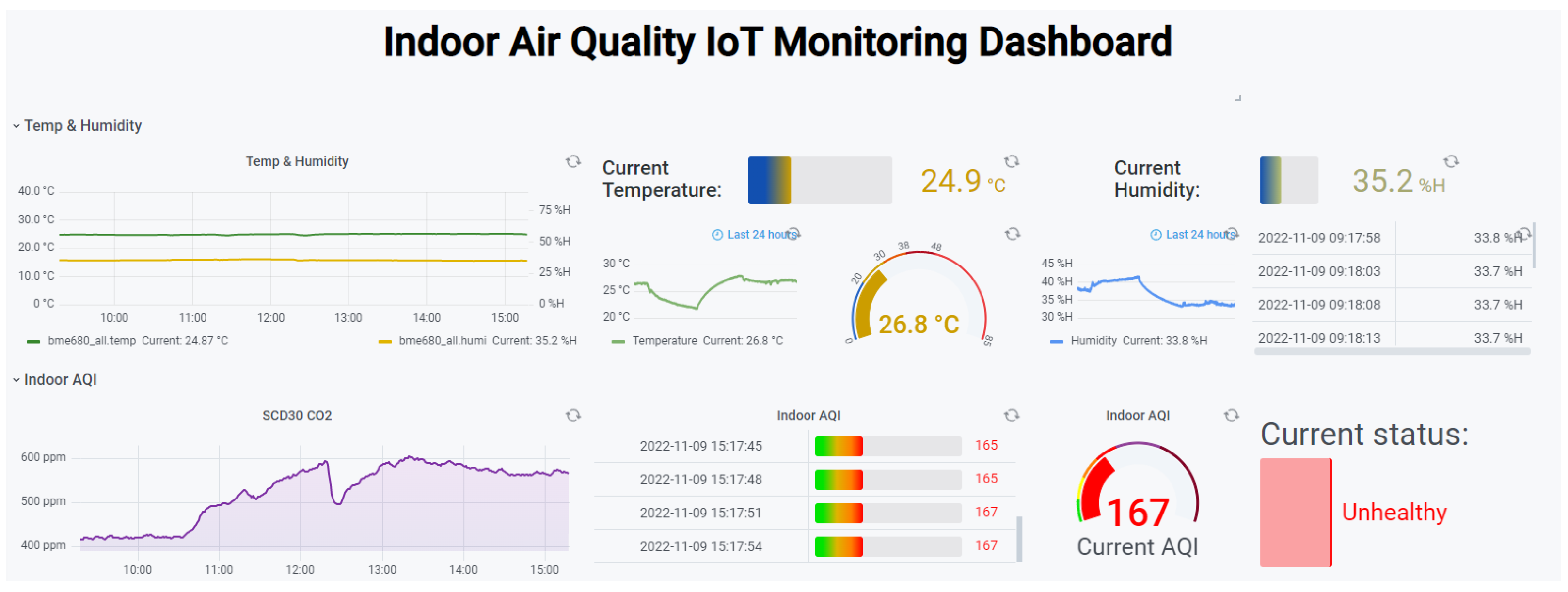

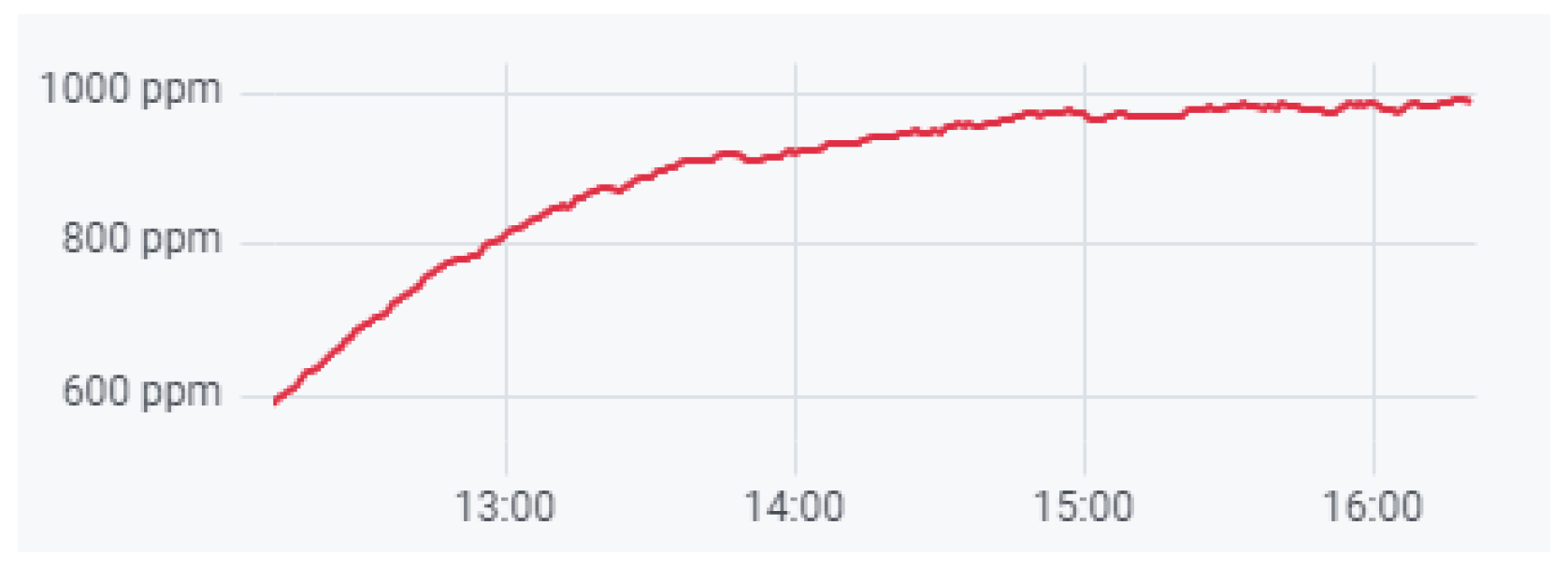

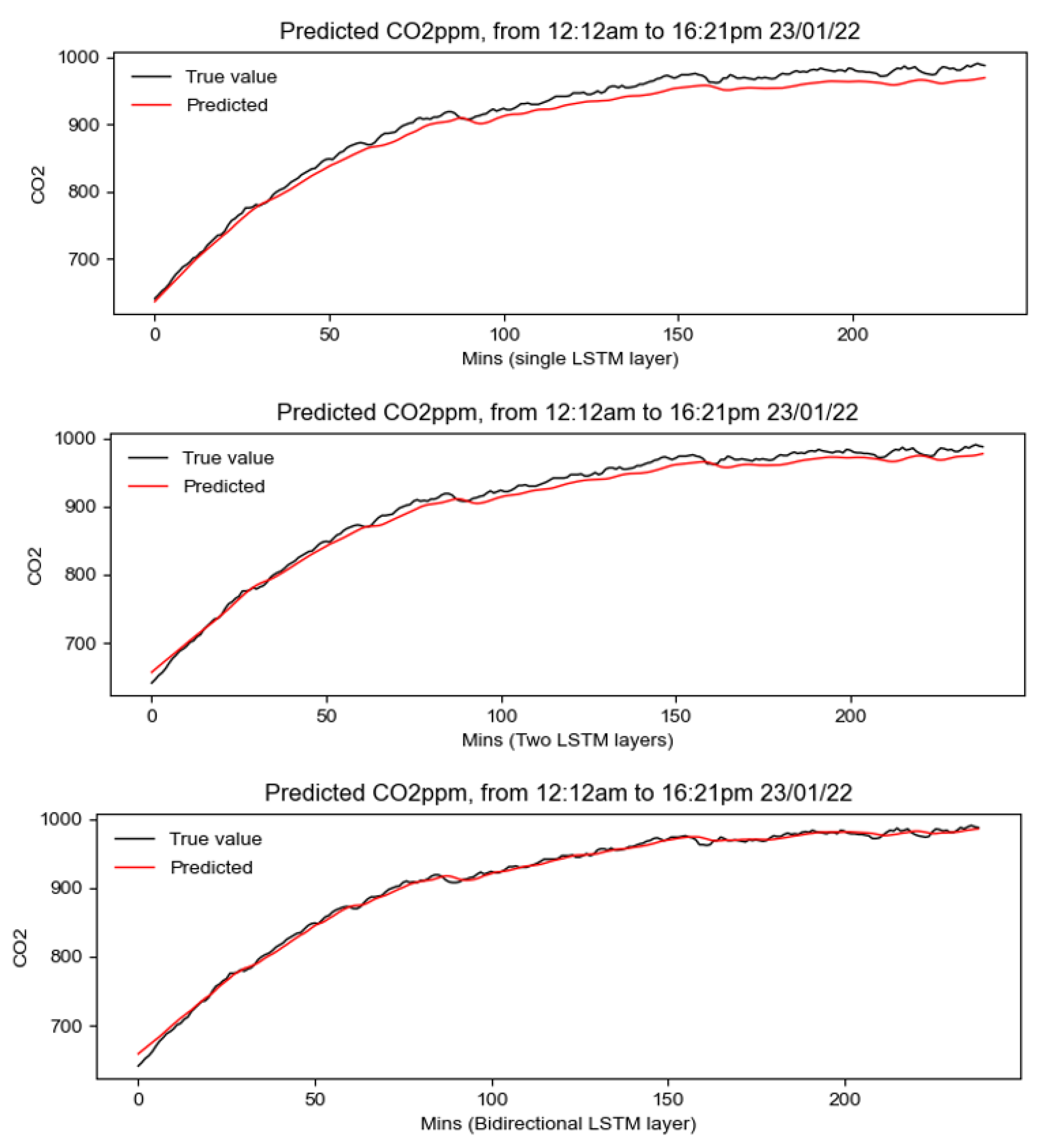
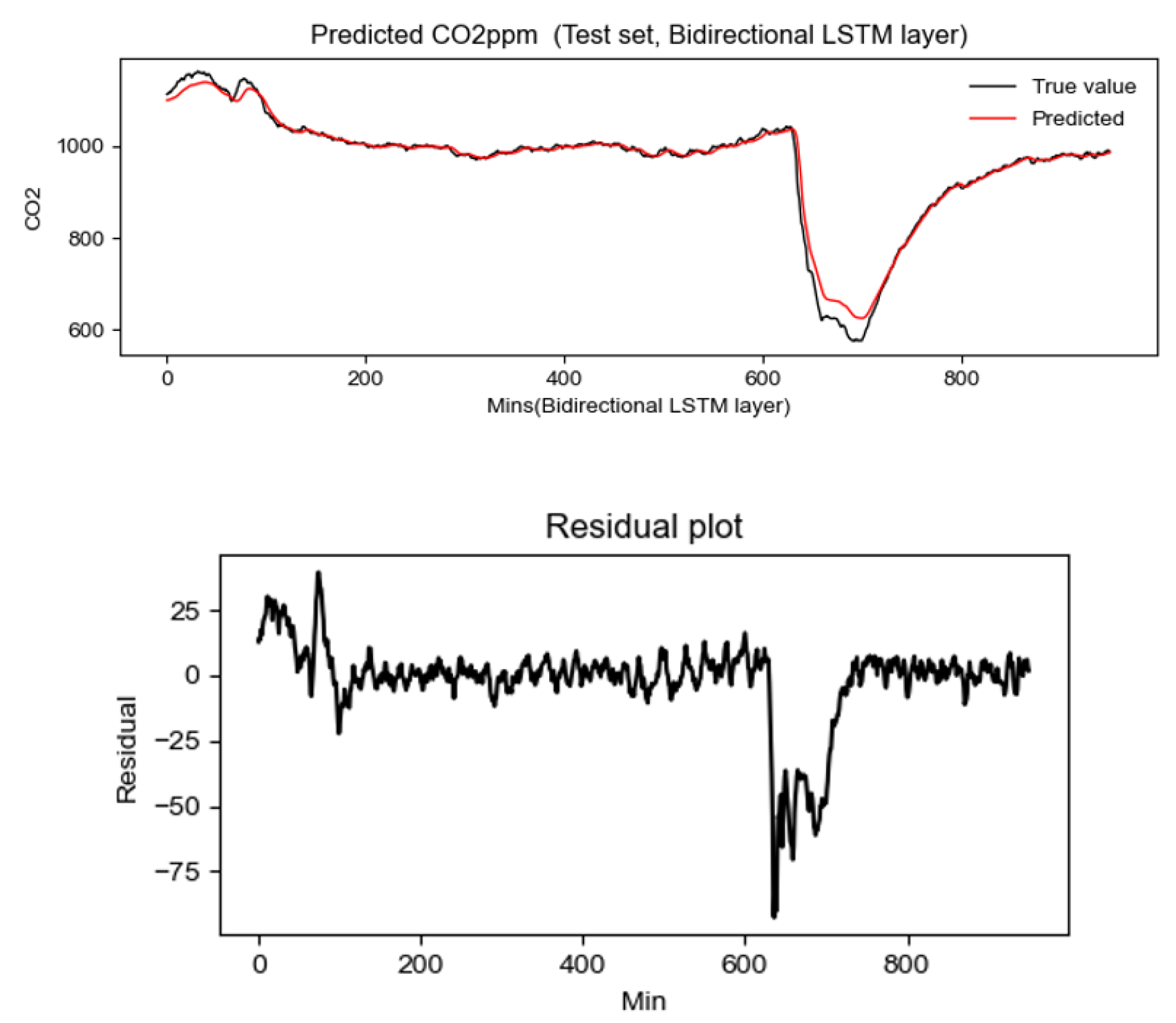
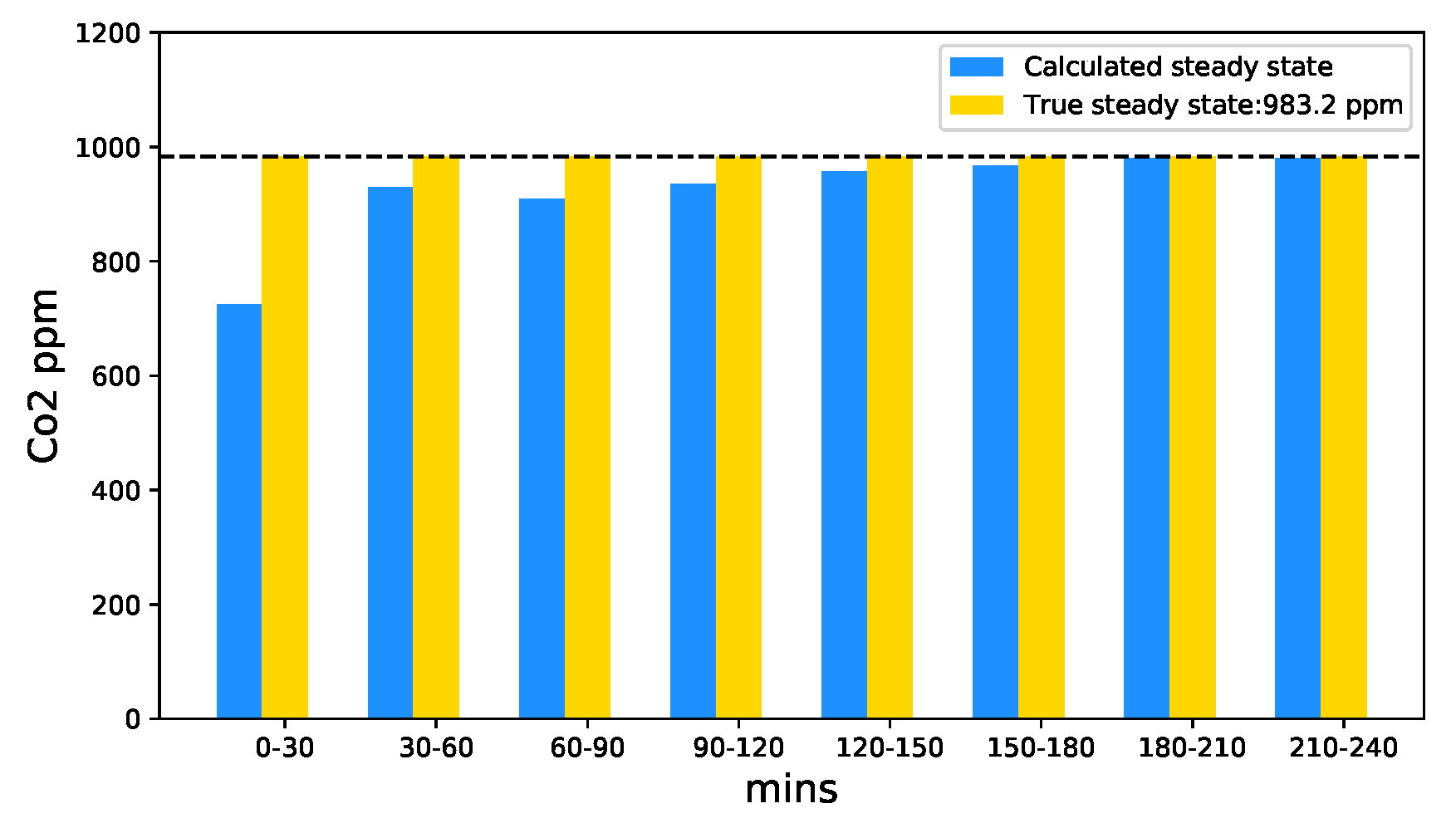
| Hyperparameter | Single Cell | Stacked | Bidirectional |
|---|---|---|---|
| Layers | 1 | 2 | 1 |
| Timestamps | 10 | 10 | 10 |
| Slide window | 1 | 1 | 1 |
| Hidden units | 32 | 32, 64 | 32 |
| Dropout | 0.5 | 0.5 | 0.5 |
| Activation function | relu | relu | relu |
| Loss function | MSE | MSE | MSE |
| Optimizer | Adam | Adam | Adam |
| MSE | RMSE | R2 | MAE | |
|---|---|---|---|---|
| Single Layer | 482.32 | 21.96 | 0.968 | 19.46 |
| Two layers | 371.35 | 19.27 | 0.975 | 13.80 |
| Bidirectional | 281.24 | 16.77 | 0.981 | 8.95 |
Disclaimer/Publisher’s Note: The statements, opinions and data contained in all publications are solely those of the individual author(s) and contributor(s) and not of MDPI and/or the editor(s). MDPI and/or the editor(s) disclaim responsibility for any injury to people or property resulting from any ideas, methods, instructions or products referred to in the content. |
© 2022 by the authors. Licensee MDPI, Basel, Switzerland. This article is an open access article distributed under the terms and conditions of the Creative Commons Attribution (CC BY) license (https://creativecommons.org/licenses/by/4.0/).
Share and Cite
Zhu, Y.; Al-Ahmed, S.A.; Shakir, M.Z.; Olszewska, J.I. LSTM-Based IoT-Enabled CO2 Steady-State Forecasting for Indoor Air Quality Monitoring. Electronics 2023, 12, 107. https://doi.org/10.3390/electronics12010107
Zhu Y, Al-Ahmed SA, Shakir MZ, Olszewska JI. LSTM-Based IoT-Enabled CO2 Steady-State Forecasting for Indoor Air Quality Monitoring. Electronics. 2023; 12(1):107. https://doi.org/10.3390/electronics12010107
Chicago/Turabian StyleZhu, Yingbo, Shahriar Abdullah Al-Ahmed, Muhammad Zeeshan Shakir, and Joanna Isabelle Olszewska. 2023. "LSTM-Based IoT-Enabled CO2 Steady-State Forecasting for Indoor Air Quality Monitoring" Electronics 12, no. 1: 107. https://doi.org/10.3390/electronics12010107
APA StyleZhu, Y., Al-Ahmed, S. A., Shakir, M. Z., & Olszewska, J. I. (2023). LSTM-Based IoT-Enabled CO2 Steady-State Forecasting for Indoor Air Quality Monitoring. Electronics, 12(1), 107. https://doi.org/10.3390/electronics12010107







